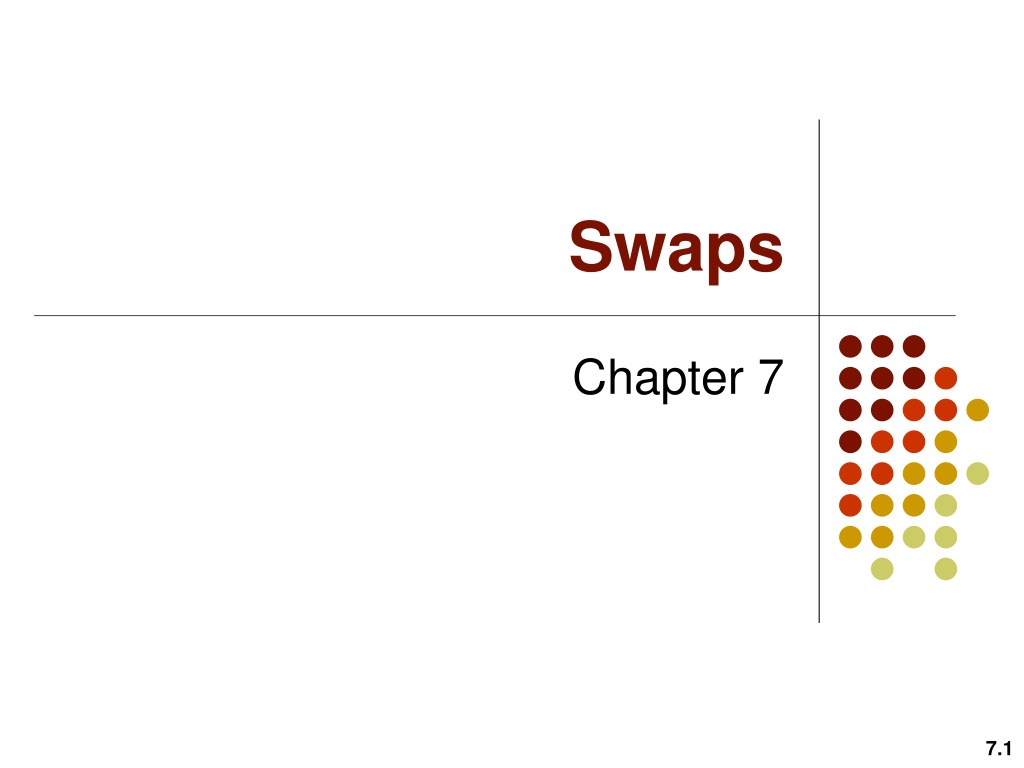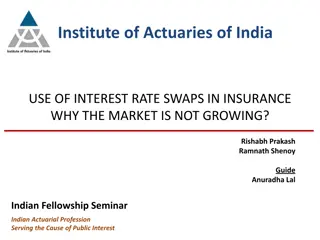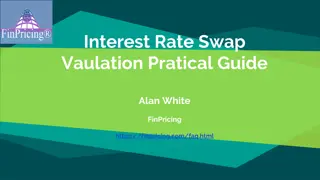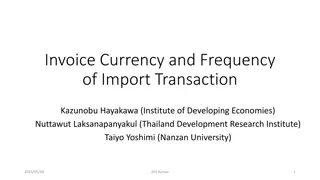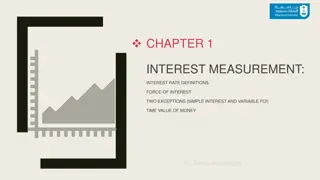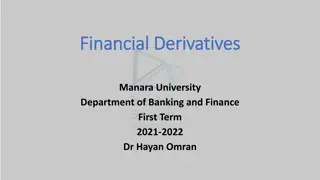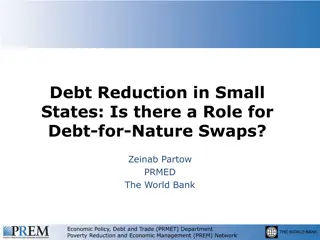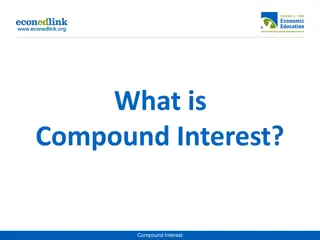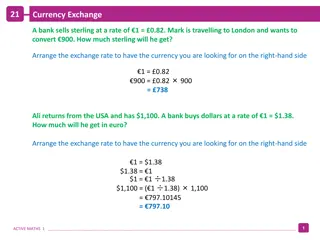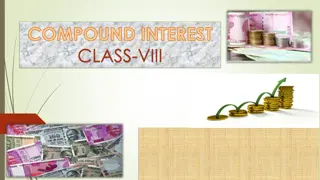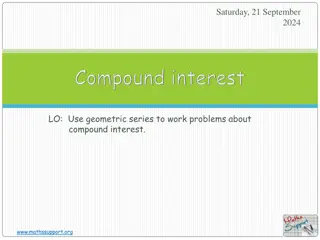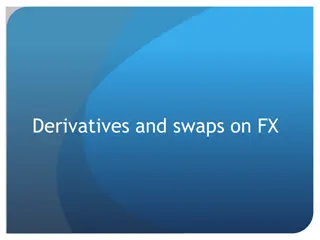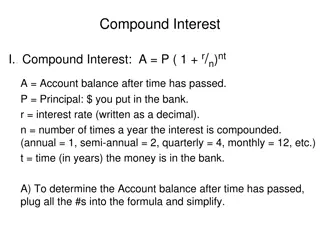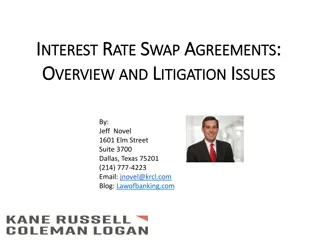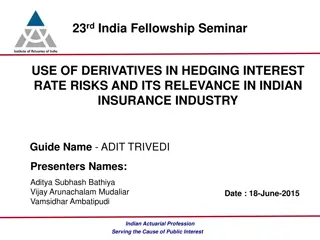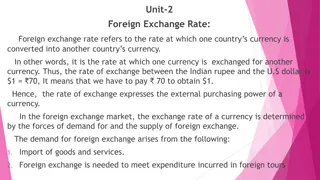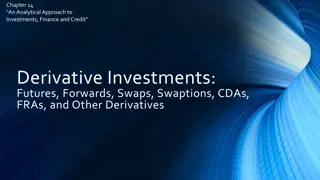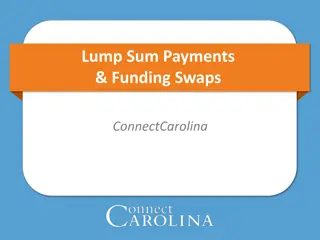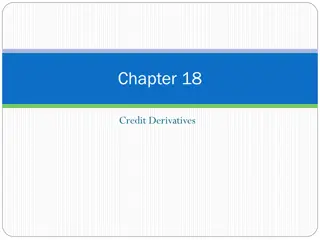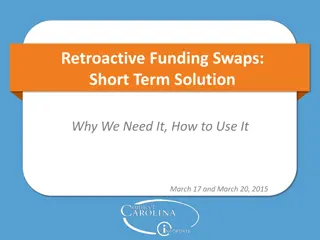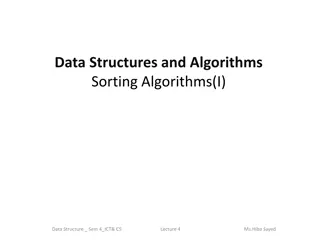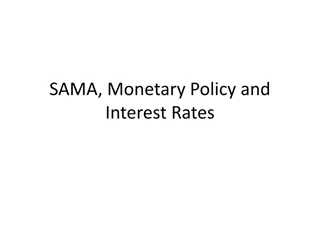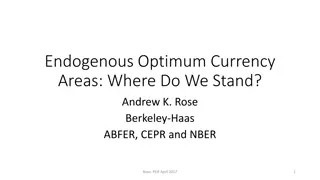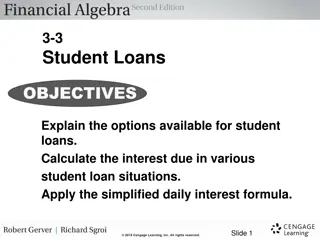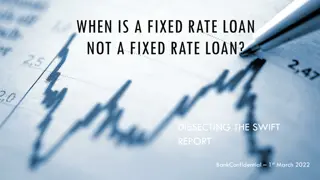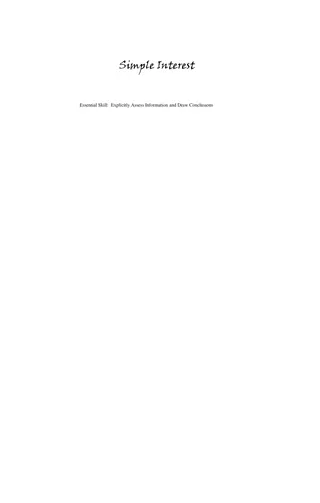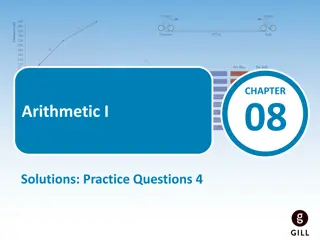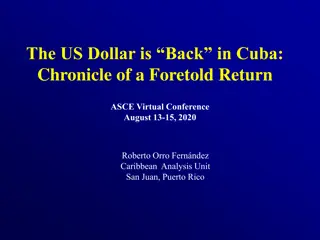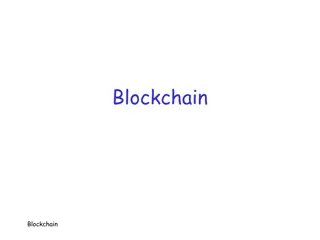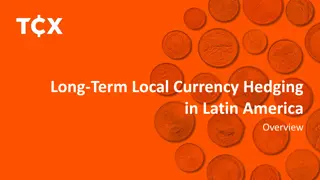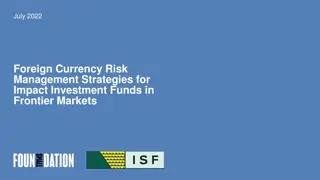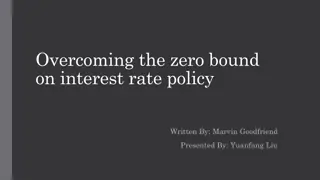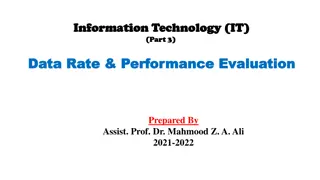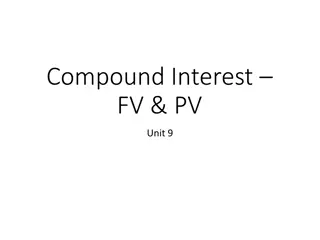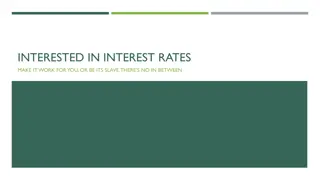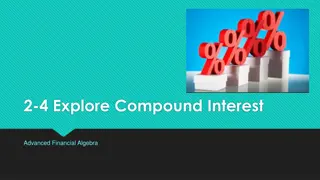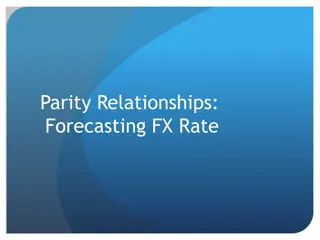Understanding Interest Rate and Currency Swaps
Introduction to interest rate swaps (IR) and currency swaps, covering definitions, examples, reasons for use, valuation, payoffs, credit risk, and other swap types. Details include the concept of swaps, calculation of cash flows, and a focus on interest rate swaps with examples and cash flow illustrations.
Download Presentation

Please find below an Image/Link to download the presentation.
The content on the website is provided AS IS for your information and personal use only. It may not be sold, licensed, or shared on other websites without obtaining consent from the author. Download presentation by click this link. If you encounter any issues during the download, it is possible that the publisher has removed the file from their server.
E N D
Presentation Transcript
Swaps Chapter 7 7.1
Goals of Chapter 7 Introduce interest rate (IR) swaps ( ) Definition for swaps An illustrative example for IR swaps Discuss reasons for using IR swaps Quotes and valuation of IR swaps Introduce currency swaps ( ) Payoffs, reasons for using currency swaps, and the valuation of currency swaps Credit risk of swaps ( , CDS) Other types of swaps 7.2
Definition of Swaps A swap is an agreement to exchange a series of cash flows (CFs) at specified future time points according to certain specified rules The first swap contracts were created in the early 1980s FYI, first futures contract appeared in 1864 Swaps are traded in OTC markets Swaps now occupy an important position in OTC derivatives markets The calculation of CFs can depend on the future values of an interest rate, an exchange rate, or other market variables 7.4
Interest Rate Swap The most common type of swap is a plain vanilla IR swap One party agrees to pay CFs at a fixed rateon a notional principal for several years The other party pay CFs at a floating rate on the same notional principal for the same period of time The floating rate in most IR swaps depends on the LIBORs with different maturities in major currencies An illustrative example: On Mar. 5 of 2023, Microsoft (MS) agrees to receive 6-month LIBOR and pay a fixed rate of 5% with Intel every 6 months for 3 years on a notional principal of $100 million 7.5
Cash Flows of an Interest Rate Swap Floating Cash Flow (mil. $) Net Fixed Cash Flow (mil. $) LIBOR Rate Cash Flow (mil. $) Date Mar. 5, 2023 4.2% Sept. 5, 2023 4.8% +2.10 2.50 0.40 Mar.5, 2024 5.3% +2.40 2.50 0.10 Sept. 5, 2024 5.5% +2.65 2.50 +0.15 Mar.5, 2025 5.6% +2.75 2.50 +0.25 Sept. 5, 2025 5.9% +2.80 2.50 +0.30 Mar. 5, 2026 +2.95 2.50 +0.45 For each reference period, the 6-month LIBOR in the beginning of the period determine the payment amount at the end of the period Therefore, there is no uncertainty about the first CF exchange The principal is also known as the notional principal ( ), or just the notional Only net CFs change hands not necessary to exchange the principal at any time point 7.6
Cash Flows of an Interest Rate Swap If the Principal was Exchanged Floating Cash Flow (mil. $) Net Fixed Cash Flow (mil. $) LIBOR Rate Cash Flow (mil. $) Date Mar. 5, 2023 4.2% Sept. 5, 2023 4.8% +2.10 2.50 0.40 Mar.5, 2024 5.3% +2.40 2.50 0.10 Sept. 5, 2024 5.5% +2.65 2.50 +0.15 Mar.5, 2025 5.6% +2.75 2.50 +0.25 Sept. 5, 2025 5.9% +2.80 2.50 +0.30 Mar. 5, 2026 +102.95 102.50 +0.45 If the principal were exchanged at the end of the life of the swap, the nature (or said the net CFs) of the deal would not be changed in any way An IR swap can be regarded as the exchange of a fixed-rate bond (with the CFs in the 4th column) for a floating-rate bond (with the CFs in the 3rd column) This characteristic helps to evaluate IR swaps (introduced later) 7.7
Interest Rate Swap Day count conventions for IR swaps in the U.S. Since the 6-month LIBOR is a U.S. money market rate, it is quoted on an actual/360 basis As for the fixed rate, it is usually quoted as actual/365 For the first CF exchange on Slide 7.6 and supposing there are 184 days between Mar. 5, 2023 and Sep. 5, 2023, the accurate CF amounts are $100 mil. 4.2% 184 360= $2.1467 mil. (for the floating-rate CF) $100 mil. 5% 184 365= $2.5205 mil. (for the fixed-rate CF) For clarity of exposition, this day count issue is ignored in the rest of this chapter 7.8
Interest Rate Swap Reasons for using IR swaps 1. Converting a liability from fixed rate (originally) to floating rate floating rate (originally) to fixed rate Intel (wants floating-rate debt) and MS (wants fixed-rate debt) 5% LIBOR + 0.1% 5.2% MS Intel LIBOR Original floating- rate debt of MS IR swap Original fixed- rate debt of Intel The net borrowing rate for Intel s liability is LIBOR + 0.2% The net borrowing rate for MS s liability is 5.1% 7.9
Interest Rate Swap 2. Converting an investment income from fixed rate (originally) to floating rate floating rate (originally) to fixed rate Intel (wants fixed-rate income) and MS (wants floating-rate income) 5% 4.7% LIBOR 0.2% MS Intel LIBOR Original fixed-rate asset of MS IR swap Original floating- rate asset of Intel The net interest rate earned for Intel s asset is 4.8% The net interest rate earned for MS s asset is LIBOR 0.3% 7.10
Interest Rate Swap Role of a financial intuition (F.I.) in IR swap Usually two nonfinancial companies do not contact directly to arrange a swap It is unlikely for a company to find a trading counterparty which needs the opposite position of the IR swap, i.e., another firm agrees with the principal and maturity but has a different preference for the floating or fixed IR Thus, a F.I. helps to match the deal and earns a spread 5.015% 4.985% LIBOR + 0.1% 5.2% MS F.I. Intel LIBOR LIBOR Original floating- rate debt of MS Original fixed- rate debt of Intel IR swap IR swap 7.11
Interest Rate Swap 5.015% 4.985% 4.7% LIBOR 0.2% MS F.I. Intel LIBOR LIBOR Original fixed-rate asset of MS Original floating- rate asset of Intel IR swap IR swap The F.I. has two separate IR swaps and it has to honor the both contracts even if Intel or MS defaults In most cases, Intel and MS even do not know whether the F.I. has entered into an offsetting swap with another firm In OTC markets for swaps, there are many F.I. s acting as market markers (or said dealers) and always preparing to trade IR swaps without having an offsetting swap They can hedge their unoffset swap positions with Treasury bonds, FRAs, or other IR derivatives 7.12
Quotes By a Swap Market Maker Maturity 2 years 3 years 4 years 5 years 7 years 10 years Bid (%) 2.55 2.97 3.15 3.26 3.40 3.48 Ask (%) 2.58 3.00 3.19 3.30 3.44 3.52 Swap Rate (%) 2.565 2.985 3.170 3.280 3.420 3.500 IR swaps are quoted as the rate for the fixed-rate side Bid rate: the fixed rate that the market maker pays for buying (receiving) a series of CFs according to LIBOR Ask rate: the fixed rate the market marker earns for selling (paying) a series of CFs according to LIBOR Swap Rate: the fixed rate such that the value of this swap is zero (introduced later), and the bid-offer quotes usually center on the swap rate in practice Plain vanilla fixed-for-floating swaps are usually structured so that financial institution can earn bid-ask spreads about 0.03% to 0.04% in the U.S. 7.13
Comparative Advantage Argument The comparative advantage argument explains the popularity of the IR swaps AAA Corp. prefers to borrow at a floating rate and BBB Corp. prefers to borrow at a fixed rate The fixed or floating IRs they need to pay are Fixed Floating AAA Corp. BBB Corp. 4.00% 5.20% 6-month LIBOR 0.1% 6-month LIBOR + 0.6% A key feature is that the difference between the two fixed rates (1.2%) is greater than the difference between the two floating rates (0.7%) AAA (BBB) Corp. has comparative advantage in borrowing fixed-rate (floating-rate) debt 7.14
Comparative Advantage Argument An ideal win-win solution with a swap AAA Corp. borrows fixed-rate funds at 4% BBB Corp. borrows floating-rate funds at LIBOR + 0.6% Both enter into a fixed-for-floating IR swap to obtain the IRs they prefer 4.35% 4% LIBOR + 0.6% BBB AAA LIBOR Borrow at a floating rate Borrow at a fixed rate IR swap The net borrowing rate for AAA Corp. is LIBOR 0.35%, which is by 0.25% lower than LIBOR 0.1% if it borrows at a floating rate directly The net borrowing rate for BBB Corp. is 4.95%, which is by 0.25% lower than 5.2% if it borrows at a fixed rate directly 7.15
Comparative Advantage Argument Suppose AAA and BBB cannot deal directly and a F.I. is involved 4.37% 4.33% LIBOR + 0.6% 4% BBB F.I. AAA LIBOR LIBOR Borrow at a floating rate Borrow at a fixed rate IR swap IR swap The net interest rate for AAA Corp. is LIBOR 0.33%, which is by 0.23% lower than LIBOR 0.1% if it borrows at a floating rate directly The net interest rate for BBB Corp. is 4.97%, which is by 0.23% lower than 5.2% if it borrows at a fixed rate directly The spread earned by the F.I. is 0.04% In the both cases, the total gains of all participants is 0.5% , which equals (1.2% 0.7%), where 1.2% (0.7%) is the difference between the fixed (floating) borrowing IRs for AAA and BBB Corp.7.16
Criticism of the Comparative Advantage Argument The comparative advantage arises from the unmatched maturities for different IR rates The 4% and 5.2% rates available to AAA and BBB are, for example, 5-year rates The LIBOR 0.1% and LIBOR + 0.6% rates are available to AAA and BBB for only 6 months (The fixed IR level or the spread above or below the LIBOR reflects the credit risks of AAA and BBB corporations) Why BBB, a worse credit-rating corp., has a comparative advantage on borrowing at a short-term IR? The 6-month period is relatively short (compared with 5 years), the 6-month default prob. of BBB is significantly lower than that that for 5 years The above effect is weak for AAA, a better credit-rating corp.7.17
Criticism of the Comparative Advantage Argument In practice, the floating-rate loan will be reviewed (so as the creditworthiness of the borrower) and rolled over every 6 months, so the true cost to borrow at a floating rate is (LIBOR + spread) rather than (LIBOR + 0.6%) for BBB spread changes with the creditworthiness of BBB With the IR swaps on Slide 7.16, the net borrowing rate for BBB is NOT FIXED at (LIBOR + 0.6%) + 4.37% LIBOR = 4.97% for 5 years, but is (LIBOR + spread) + 4.37% LIBOR = 4.37% + spread dependent on its future creditworthiness every 6 months In contrast, if BBB borrows at a fixed IR, the borrowing rate is fixed at 5.2% for 5 years, regardless of its future creditworthiness As a result, BBB cannot achieve its goal perfectly with an IR swap if its creditworthiness changes in the future The above inference disproves that the comparative advantage argument can fully explain the popularity of IR swaps 7.18
The Nature of Swap Rates The n-year swap rate is a constant interest rate corresponding to a credit risk for lending 2n consecutive 6-month LIBOR loans to AA-rated companies First, the LIBOR is the lending rate for an AA-rated borrower Second, a F.I. can earn the n-year swap rate by 1. Lending for the first 6-month loan to an AA-rated borrower and relending it for successive 6-month periods to another AA-rated borrowers, and continue this process for n years 2. Entering into a IR swap to exchange the LIBOR income in the above step for the constant CFs at the n-year swap rate7.19
The Nature of Swap Rates Note that the n-year swap rates are lower than n- year AA-rating lending rates (LOBOR) For the swap rate, the credit rating of the borrower is always AA at the beginning of every 6-month period in n years For n-year lending rates applicated to AA-rated banks, it is only known that the initial credit rating of the borrower is AA at the beginning of the n-year period Credit risk borne for earning n-year swap rate is smaller than that for earning n-year AA-rating lending IR level comparison: n-year swap rate < n-year LIBOR Furthermore, it can be inferred that the swap rates are even closer to risk free (compared with LIBORs applicable to AA-rated banks) 7.20
Valuation of IR Swaps There are two approaches to price IR swaps 1. Regard the value of an IR swap as the difference between the values of a fixed-rate bond and a floating-rate bond (see Slide 7.7) 2. Regard an IR swap as a portfolio of forward rate agreements (FRAs) For the Intel and MS 3-year IR swap, it can be regarded separately as 5 FRAs (excluding the first exchange) 7.21
Valuation of IR Swaps Valuation in terms of bond prices For a swap where fixed CFs are received and floating CFs are paid, its value can be expressed as ?swap= ?fix ?fl, where ?fix and ?fl denote the values of a fixed-rate and floating-rate bonds The value of a fixed-rate bond (Bfix) can be derived with the traditional discounted cash flow method The value of a floating-rate bond (Bfl) that pays 6- month LIBOR is equal to its par value immediately after each coupon payment date (if it is discounted semiannually) 7.22
Valuation of IR Swaps Pricing Bfl (with the par value to be $100) with 1.5 years to maturity in one possible scenario for the 6-month LIBOR $100+$2 $3 $4 4% 6% 8% t=0 t=0.5 t=1 t=1.5 Earn interest income of $4 and deposit $100 for another 0.5 years Earn interest income of $3 and deposit $100 for another 0.5 years Deposit $100 for 0.5 years Note that in any scenario for LIBOR movements and for different bond maturities, the fair value of Bfl should be its par value on the issue date Moreover, Bfl should be also worth at its par value on each date immediately after the coupon payment date 7.23
Valuation of IR Swaps Generalization for pricing a Bfl (with the principal (or said par value) L) at any time point ? Value = L = PV of L+k* at t = 0 Value = L Value = L+k* t 0 t* Last Valuation Date First Pmt Date (Floating CF = k*) Second Pmt Date Maturity Date Pmt Date A Bfl is worth the PV of (? + ? ) at ?, i.e., ? + ? ? ?(? ?), where ? + ? is the value of the Bfl on the next payment date and ? is the continuously compounding zero rate corresponding to the time to maturity of (? ?) 7.24
Valuation of IR Swaps An example for pricing pay-floating-receive- fixed IR swaps For the party to pay the six-month LIBOR and receive fixed 8% (semi-annual compounding) on a principal of $100 million Remaining life of the IR swap is 1.25 years LIBOR rates for 3-months, 9-months and 15- months are 10%, 10.5%, and 11% (continuously compounding) The 6-month LIBOR on the last payment date was 10.2% (semi-annual compounding) 7.25
Valuation of IR Swaps Time (yr) 0.25 0.75 1.25 Total ????CF ???CF Discount Factor PV of ???? CF $3.901 $3.697 $90.640 $98.238 PV of ??? CF $102.505 $4 $4 $105.1 ? 10% 0.25= 0.9753 ? 10.5% 0.75= 0.9243 ? 11% 1.25= 0.8715 $104 $102.505 For per $100 principal The coupon payment of ?fl after 3 months is 0.5 10.2% $100 = $5.1 The value of ?fl today is $100 + $5.1 ? 10% 3/12= $102.505 according to the formula on Slide 7.24 ?swap= ?fix ?fl= $98.238 $102.505 = $4.267 7.26
Valuation of IR Swaps Valuation in terms of FRAs Each exchange in an IR swap is an FRA For a newly issued IR swap, the net value of the first exchange and its PV are known when the swap is created For each of other exchanges, it can be regarded as a FRA applied for a future period of 6 months Recall that for a FRA applied in [?1,?2], the payoff of the lender at ?2 is ?(?? ??) ?2 ?1 (see Slide 4.46), where ? is the principal, ?? is the fixed IR specified in the FRA contract, and ?? is the actual LIBOR for [?1,?2] Considering a pay-floating-receive-fixed IR swap with the principal ?, for each 6 months, the swap holder can receive the net payoff of ? ?? ?? 0.5, where ?? is the actual 6-month LIBOR for that period and ?? is the fixed IR specified in the swap contract 7.27
Valuation of IR Swaps The value of any derivative equals the present value of its expected payoff To evaluate the expected payoff of an exchange in an IR swap, the expectation of the future LIBOR is needed ? ?2?2? ? ?? ?? = ? ?2?2? ?? ?[??] ?2 ?1 = ? ?2?2?[???2 ?1 ?[??] ?2 ?1] It is known that the expected future LIBORs equal the forward rates (??) based on today s term structure of IRs: Value of an exchange = ? ?2?2?[???2 ?1 ???2 ?1] = ? ?2?2?(?? ??) ?2 ?1 The above formula is identical to the FRA pricing formulas on Slides 4.48 and 4.49 ?2 ?1 7.28
Valuation of IR Swaps Consider the pay-floating-receive-fixed IR swap example on Slide 7.25. For per $100 principal, Time (yr) 0.25 0.75 1.25 Total Fixed CF Expected floating CF $5.100 $5.522* $6.051** Expected net CF $1.100 $1.522 $2.051 Discount factor 0.9753 0.9243 0.8715 PV of expected net CF $1.073 $1.407 $1.787 $4.267 $4 $4 $4 ??=10.5% 0.75 10% 0.25 Expected cash outflow at ? = 0.75 is $100 11.044% 0.5 = $5.522 = 10.75% (cont. comp.) 11.044% (semi-annual comp.) 0.5 ??=11% 1.25 10.5% 0.75 Expected cash outflow at ? = 1.25 is $100 12.102% 0.5 = $6.051 = 11.75% (cont. comp.) 12.102% (semi-annual comp.) 0.5 7.29
Valuation of IR Swaps An IR swap is worth zero when it is first initiated When a swap contract is first negotiated, the swap rate (the fixed rate ??) is determined such that the value of the swap is zero initially This feature is similar to set the delivery prices of futures contracts to be the futures prices such that the futures contracts are worth zero when they are initiated With the passage of time, the value of an IR swap emerges and can be either positive or negative One party s gains are the other party s losses, so two parties of a swap have opposite viewpoints on the value of the same IR swap 7.30
Valuation of IR Swaps Although the swap is zero initially, it does not mean that the value of each individual FRA is zero initially The initial zero value of a swap means that the sum of the values of all FRAs underlying the swap is zero For a pay-fixed-receive-floating swap on the issue date, If the zero curve is upward sloping forward rates with T The forward rates with shorter times to maturity < the swap rate negative values for shorter-maturity FRAs The forward rates with longer times to maturity > the swap rate positive values for longer-maturity FRAs If the zero curve is downward sloping forward rates with T The forward rates with shorter times to maturity > the swap rate positive values for shorter-maturity FRAs The forward rates with longer times to maturity < the swap rate negative values for longer-maturity FRAs 7.31
Determine LIBOR Zero Curve with Eurodollar Futures and IR Swaps Construct the LIBOR zero curve (It is important since LIBORs can be used as proxies for risk-free rates when trading derivatives) ? < 1: the quotes of spot LIBOR (given different ?) offered by financial institutions are used ? in [1,2] (or in [1,5]): the quotes of Eurodollar futures are used to derive LIBOR zero rates Suppose the zero rate ?1 for ?1 is known With the convexity adjustment on Slide 6.33, the forward rates (??) for [?1,?2] can be derived from the futures rates implied from the quotes of Eurodollars futures (?) Finally, we can deduce ?2 through ??=?2?2 ?1?1 ?2 ?1 ?2=???2 ?1+?1?1 7.32 ?2
Determine LIBOR Zero Curve with Eurodollar Futures and Swaps For longer ?: the quotes of swap rates are used to derive the LIBOR zero rate Consider a pay-floating-receive-fixed IR swap with the swap rate of 5%, principal of $100, and 2 years to maturity Suppose the 6-month, 12-month, and 18-month LIBOR zero rates are 4%, 4.5%, and 4.8% with cont. compounding Since the initial value of a swap is zero, then ?swap= ?fix ?fl= ?fix $100 = 0 and thus 2.5? 4% 0.5+ 2.5? 4.5% 1+ 2.5? 4.8% 1.5+ 102.5? ? 2= 100 Solve for the 2-year LIBOR zero rate to be 4.953% The above equation also demonstrates that the swap rate (5%) = par yield (defined on Slide 4.27) Similar to the bootstrap method, LIBOR rates for shorter ? should be solved first before solving LIBOR rates for longer ?7.33
Overnight Indexed Swaps (OISs) OIS (overnight indexed swap) rates ( ) An OIS is a swap where a fixed rate ( ?) is exchanged for the geometric average ( ??) of the overnight rates (effective federal funds rates) during a period For a 3-month (supposed to be 92 days) OIS, 1 + ??/365 at the end of the 3-month period, where the notional principal is assumed to be $1 for simplicity The fixed rate ? is referred to as the OIS rate, determined such that an OIS is worth zero initially 92 1 92/365 ? will be exchanged 7.34
Overnight Indexed Swaps (OISs) For maturities up to one year, there is a single exchange for an OIS at maturity Longer-term OISs are typically divided into 3-month sub-periods At the end of each sub-period, the net of the actual geometric average of the overnight rates during the sub-period and the fixed OIS rate will be exchanged A bank can earn the OIS rate by 1. Relending overnight loans by rolling the interest and principal forward every day (to earn 1 + ??/365 92 1 ) 92 1 for 2. Entering into an OIS to exchange 1 + ??/365 92/365 ? 7.35
Overnight Indexed Swaps (OISs) OIS rates are now used as a proxy for risk-free rates OIS rates are continually refreshed overnight rates Credit qualities of borrowers are known before daily overnight lending In contrast, to earn 3-month LIBORs, the bank bears the default risk of its trading counterparty, which is rated AA initially and could change with the passage of time Comparing to LIBOR or swap rates, to earn OIS rates is further like a risk-free investment In practice, many derivatives dealers choose to use OIS zero rates for discounting collateralized transactions (less risky) and use LIBOR zero rates for discounting noncollateralized transactions (more risky) 7.36
Determine an OIS Zero Curve Similar to constructing a LIBOR zero curve with swap rates, one can derive a zero curve using OIS quotes (a better proxy for the term structure of the risk-free interest rate) ? < 1 year: OIS rates can be treated like zero rates For a longer ? (assuming there are periodic settlements (usually every 3 months) in OIS contracts) The compounding frequency with which OIS rates are expressed reflects the frequency of payments For a 1.25-year OIS contract with the OIS rate to be 4%, it can be regarded as a bond paying a quarterly coupon at a rate of 4% per annum and sold at par 7.37
Determine Zero Curve Using OISs Suppose the 3-, 6-, 9-, and 12-month OIS zero rates are 3%, 3.5%, 4%, and 4.5% with continuous compounding The 1.25-year OIS zero rate ? is 3.9798% by solving 1? 3% 0.25+ 1? 3.5% 0.5+ 1? 4% 0.75+ 1? 4.5% 1+ 101? ? 1.25= 100 For a ? being so long such that the quotes of OIS rates are not available or unreliable, e.g., ? > 5 years Note that LIBOR-based IR swaps are traded for longer maturities than OIS Assume the (LIBOR OIS) spread is constant and as it is for the longest OIS maturity for which there is reliable data, e.g., for the 5-year time point, the corresponding (LIBOR OIS) zero-rate spread is 20 basis points Use the LIBOR zero curve minus a constant (LIBOR OIS) spread to derive the OIS rate zero curve 7.38
7.2 Currency Swaps 7.39
Currency Swap Currency swap is another popular type of swaps It involves exchanging principal and interest payments in one currency for principal and interest payments in another currency Different from IR swaps, the principal amounts (in different currencies) are exchanged at the beginning and at the end of the life of a currency swap The principal amounts are chosen to be approximately equivalent using the exchange rate at the swap s initiation An example of a currency swap: IBM pays 5% on a principal of 10,000,000 and receive 6% on a principal of $15,000,000 from British Petroleum (BP) every year for 5 years 7.40
Currency Swap 10 mil. Year Dollar CF for IBM (millions) 15.00 +0.90 +0.90 +0.90 +0.90 +15.90 Sterling CF for IBM (millions) +10.0 0.5 0.5 0.5 0.5 10.5 BP IBM $15 mil. 2013 2014 2015 2016 2017 2018 Dollar 6% BP IBM Sterling 5% A currency swap can be regarded as two parallel loans denominated in different currencies The values of $15 mil. and 10 mil. are set to be equivalent initially (in this case, 1 =$1.5 initially) Two parties lend loans with equivalent values to each other The net value of the currency swap is zero initially $15 mil. BP IBM 10 mil. 7.41
Currency Swap Typical uses of a currency swap is to Convert a liability in one currency to a liability in another currency Dollar 6% Sterling 5% Dollar 6% BP IBM Sterling 5% Convert an investment in one currency to an investment in another currency Dollar 6% Dollar 6% BP IBM Sterling 5% Sterling 5% 7.42
Comparative Advantage Arguments for Currency Swaps The comparative advantage argument explains the popularity of the currency swaps General Electric (GE) prefers to borrow AUD and Qantas Airways (QA) prefers to borrow USD The USD and AUD borrowing IRs they face are USD AUD General Electric (GE) 5.0% 7.6% Qantas Airways (QA) 7.0% 8.0% GE has a comparative advantage in the USD market, whereas QA has a comparative advantage in the AUD market 7.43
Comparative Advantage Arguments for Currency Swaps Exploit the comparative advantage with currency swaps Suppose that GE intends to borrow 20 mil. AUD and QA intends to borrow 15 mil. USD, and the current exchange rate is 0.75USD per AUD GE borrows USD, QA borrows AUD, and they use currency swaps to transform GE s USD loan into a AUD loan and QA s AUD loan into a USD loan USD 6.3% USD 5.0% AUD 8.0% USD 5.0% QA F.I. GE AUD 8.0% AUD 6.9% GE pays 6.9% in AUD (0.7% better off) and QA pays 6.3% in USD (0.7% better off) 7.44
Comparative Advantage Arguments for Currency Swaps Different ways to arrange the currency swaps 1. QA bears some foreign exchange risk USD 5.2% USD 5.0% AUD 8.0% USD 5.0% QA F.I. GE AUD 6.9% AUD 6.9% 2. GE bears some foreign exchange risk USD 6.3% USD 6.1% AUD 8.0% USD 5.0% QA F.I. GE AUD 8.0% AUD 8.0% These two alternatives are unlikely to be adopted in practice because firms prefer to eliminate the foreign exchange risk with currency swaps thoroughly 7.45
Valuationof Currency Swaps Like IR swaps, currency swaps can be valued either as the difference between 2 bonds or as a portfolio of forward contracts Valuation in terms of bond prices For a receive-dollar-pay-foreign-currency currency swap, then ?swap= ?? ?0??, where ?? is the domestic bond value for the remaining USD CFs, ?? is the foreign bond value for the remaining foreign-currency CFs, and ?0 is the spot exchange rate (expressed as dollars for per unit of foreign currency) In contrast, for a pay-dollar-receive-foreign-currency currency swap, then ?swap= ?0?? ?? 7.46
Valuationof Currency Swaps An example for pricing currency swaps All Japanese LIBOR zero rates are 4% (foreign IR) All USD LIBOR zero rates are 9% (domestic IR) A currency swap is to received 5% in yen and pay 8% in dollars. Payments are made annually Principals are $10 million and 1,200 million yen Swap will last for 3 more years Current exchange rate is 110 yen per dollar 7.47
Valuationof Currency Swaps Time (yr) Cash Flows of ?? (million $) PV of ?? (million $) (discounted at 9%) 0.7311 0.6682 0.6107 7.6338 9.6439 Cash flows of ?? (million yen) PV of ?? (million yen) (discounted at 4%) 57.65 55.39 53.22 1,064.30 1,230.55 1 2 3 3 0.8 (=10 8%) 0.8 (=10 8%) 0.8 (=10 8%) 10 60 (=1,200 5%) 60 (=1,200 5%) 60 (=1,200 5%) 1,200 Total ?swap= ?0?? ??=1,230.55 9.6439 = 1.543 (million $) 110 7.48
Valuationof Currency Swaps Valuation in terms of forward contracts Each exchange of payments (including the first one) in a currency swap is a foreign exchange (FX) forward contract FX forwards is an agreement to trade an amount of a foreign currency at a fixed price on a predetermined future date FX forwards are similar to the foreign currency futures contracts (introduced in Ch. 5) except that FX forwards are traded in OTC markets and thus there is no daily settlement requirement The principal is ? foreign dollars (?= 60 or 1260 mil. in our example) and the fixed trading price is ? (expressed as domestic dollars / per foreign dollar) (? = $0.8/ 60 or $10.8/ 1260 in our example) Payoff of a FX forwards to purchase the foreign currency at ? is ? ?? ? = ??? ??, where ?? is the domestic-dollar price of a foreign dollar (or said the FX rate) at ? 7.49
Valuationof Currency Swaps The value of a FX forward is the PV of its expected payoff ? ??? ??? ?? = ? ?? (?? ?? ??) The forward (or futures) price of the foreign currency provide the unbiased approximation for ? ?? based on the information of IRs today Since the forward price of the foreign currency is ?0= ?0?(? ??)? (introduced on Slide 5.23), we obtain ? ?? = ?0= ?0?? ??? Thus, the value of a FX forward is ? ??(??0 ??) The forward FX rates of Japanese Yen, ?0, in the example on Slide 7.47 are Time (yr) 1 2 3 Forward FX rate ($/per Yen) 1 1 1 110?(9% 4%) 1 = 0.009557 110?(9% 4%) 2 = 0.010047 110?(9% 4%) 3 = 0.010562 7.50
